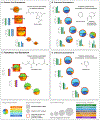Illuminating the dark metabolome of Pseudo-nitzschia-microbiome associations
- PMID: 36222155
- PMCID: PMC9707391
- DOI: 10.1111/1462-2920.16242
Illuminating the dark metabolome of Pseudo-nitzschia-microbiome associations
Erratum in
-
Correction to 'Illuminating the dark metabolome of Pseudo-nitzschia-microbiome associations'.Environ Microbiol. 2023 Jul;25(7):1374. doi: 10.1111/1462-2920.16433. Epub 2023 Jun 5. Environ Microbiol. 2023. PMID: 37272427 No abstract available.
Abstract
The exchange of metabolites mediates algal and bacterial interactions that maintain ecosystem function. Yet, while thousands of metabolites are produced, only a few molecules have been identified in these associations. Using the ubiquitous microalgae Pseudo-nitzschia sp., as a model, we employed an untargeted metabolomics strategy to assign structural characteristics to the metabolites that distinguished specific diatom-microbiome associations. We cultured five species of Pseudo-nitzschia, including two species that produced the toxin domoic acid, and examined their microbiomes and metabolomes. A total of 4826 molecular features were detected by tandem mass spectrometry. Only 229 of these could be annotated using available mass spectral libraries, but by applying new in silico annotation tools, characterization was expanded to 2710 features. The metabolomes of the Pseudo-nitzschia-microbiome associations were distinct and distinguished by structurally diverse nitrogen compounds, ranging from simple amines and amides to cyclic compounds such as imidazoles, pyrrolidines and lactams. By illuminating the dark metabolomes, this study expands our capacity to discover new chemical targets that facilitate microbial partnerships and uncovers the chemical diversity that underpins algae-bacteria interactions.
© 2022 Applied Microbiology International and John Wiley & Sons Ltd.
Figures






References
-
- Amin SA, Hmelo LR, van Tol HM, Durham BP, Carlson LT, Heal KR, et al. (2015) Interaction and signalling between a cosmopolitan phytoplankton and associated bacteria. Nature 522: 98–101. - PubMed
-
- Armbrust EV, Berges JA, Bowler C, Green BR, Martinez D, Putnam NH, et al. (2004) The Genome of the Diatom Thalassiosira Pseudonana: Ecology, Evolution, and Metabolism. Science 306: 79–86. - PubMed
-
- Bates SS, Douglas DJ, Doucette GJ, and Léger C (1995) Enhancement of domoic acid production by reintroducing bacteria to axenic cultures of the diatom Pseudo-nitzschia multiseries. Nat Toxins 3: 428–435. - PubMed
-
- Bates SS, Hubbard KA, Lundholm N, Montresor M, and Leaw CP (2018) Pseudo-nitzschia, Nitzschia, and domoic acid: New research since 2011. Harmful Algae 79: 3–43. - PubMed

